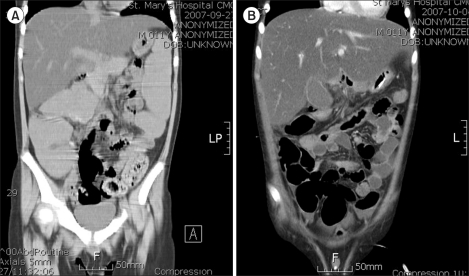Korean J Hematol.
2010 Mar;45(1):62-65. 10.5045/kjh.2010.45.1.62.
Neostigmine for the treatment of acute colonic pseudo-obstruction (ACPO) in pediatric hematologic malignancies
- Affiliations
-
- 1Department of Pediatrics, College of Medicine, The Catholic University of Korea, Seoul, Korea. chobinkr@catholic.ac.kr
- 2Department of Radiology, College of Medicine, The Catholic University of Korea, Seoul, Korea.
- KMID: 2252090
- DOI: http://doi.org/10.5045/kjh.2010.45.1.62
Abstract
- BACKGROUND
Acute colonic pseudo-obstruction (ACPO) refers to dilatation of the colon and decreased bowel motility without evidence of mechanical obstruction. Neostigmine, an acetylcholinesterase inhibitor, has been used in patients in whom supportive therapy failed to resolve ACPO. Here, we report the results of administering neostigmine to treat ACPO in children with hematologic malignancies.
METHODS
Between September 2005 and December 2009, 10 patients (8 male and 2 female) were diagnosed with ACPO at the Department of Pediatrics, Catholic University of Korea. Diagnosis of ACPO was based on typical clinical features as well as colonic dilatation found on abdominal CT imaging. Neostigmine was administered subcutaneously at a dosage of 0.01 mg/kg/dose (maximum 0.5 mg) twice daily for a maximum of 5 total doses. ACPO was determined to be responsive to neostigmine if the patient showed both stool passage and improvement of clinical symptoms.
RESULTS
The study group included 8 acute lymphoblastic leukemia patients, 1 patient with malignant lymphoma, and 1 patient with juvenile myelomonocytic leukemia. The median age at ACPO diagnosis was 8.5 years (range, 3-14). Overall, 8 patients (80%) showed therapeutic response to neostigmine at a median of 29 hours after the initial administration (range, 1-70). Two patients (20%) showed side effects of grade 2 or above, but none complained of cardiovascular symptoms that required treatment.
CONCLUSION
In this study, ACPO was diagnosed most often in late-childhood ALL patients. Subcutaneous neostigmine can be used to effectively treat ACPO diagnosed in children with hematologic malignancies without major cardiovascular complications.
MeSH Terms
Figure
Reference
-
1. Saunders MD. Acute colonic pseudo-obstruction. Best Pract Res Clin Gastroenterol. 2007; 21:671–687. PMID: 17643908.
Article2. Ponec RJ, Saunders MD, Kimmey MB. Neostigmine for the treatment of acute colonic pseudo-obstruction. N Engl J Med. 1999; 341:137–141. PMID: 10403850.3. van der Spoel JI, Oudemans-van Straaten HM, Stoutenbeek CP, Bosman RJ, Zandstra DF. Neostigmine resolves critical illness-related colonic ileus in intensive care patients with multiple organ failure--a prospective, double-blind, placebo-controlled trial. Intensive Care Med. 2001; 27:822–827. PMID: 11430537.4. McNamara R, Mihalakis MJ. Acute colonic pseudo-obstruction: rapid correction with neostigmine in the emergency department. J Emerg Med. 2008; 35:167–170. PMID: 18242923.
Article5. Rosenberg RF, Caridi JG. Vincristine-induced megacolon. Gastrointest Radiol. 1983; 8:71–73. PMID: 6832541.
Article6. Williams EV, Drew PJ, Gaffney C, Shrestha BM, Mansel RE. Pancolitis associated with docetaxel: a rare cause of megacolon. Breast. 2001; 10:346–347. PMID: 14965607.
Article7. Breccia M, Girmenia C, Mecarocci S, et al. Ogilvie's syndrome in acute myeloid leukemia: pharmacological approach with neostigmine. Ann Hematol. 2001; 80:614–616. PMID: 11732875.8. Khosla A, Ponsky TA. Acute colonic pseudoobstruction in a child with sickle cell disease treated with neostigmine. J Pediatr Surg. 2008; 43:2281–2284. PMID: 19040954.
Article9. Kim TS, Lee JW, Kim MJ, et al. Acute colonic pseudo-obstruction in postchemotherapy complication of brain tumor treated with neostigmine. J Pediatr Hematol Oncol. 2007; 29:420–422. PMID: 17551407.
Article10. Legha SS. Vincristine neurotoxicity. Pathophysiology and management. Med Toxicol. 1986; 1:421–427. PMID: 3540519.
- Full Text Links
- Actions
-
Cited
- CITED
-
- Close
- Share
- Similar articles
-
- Effective and Safe Use of Neostigmine in Treatment of Acute Kidney Injury Associated with Colonic Pseudo-obstruction after Cardiac Surgery
- A Case of Neostigmine Trial in Acute Colonic Pseudo-obstruction
- Acute colonic pseudo-obstruction following allogeneic stem cell transplantation successfully treated by neostigmine
- A Case of Acute Colonic Pseudo-Obstruction Combined with Rhabdomyolysis induced by Severe Hypokalemia
- Eosinophilic Peritonitis Followed by Acute Colonic Pseudo-obstruction (Ogilvie's syndrome) in an ESRD Patient on CAPD


